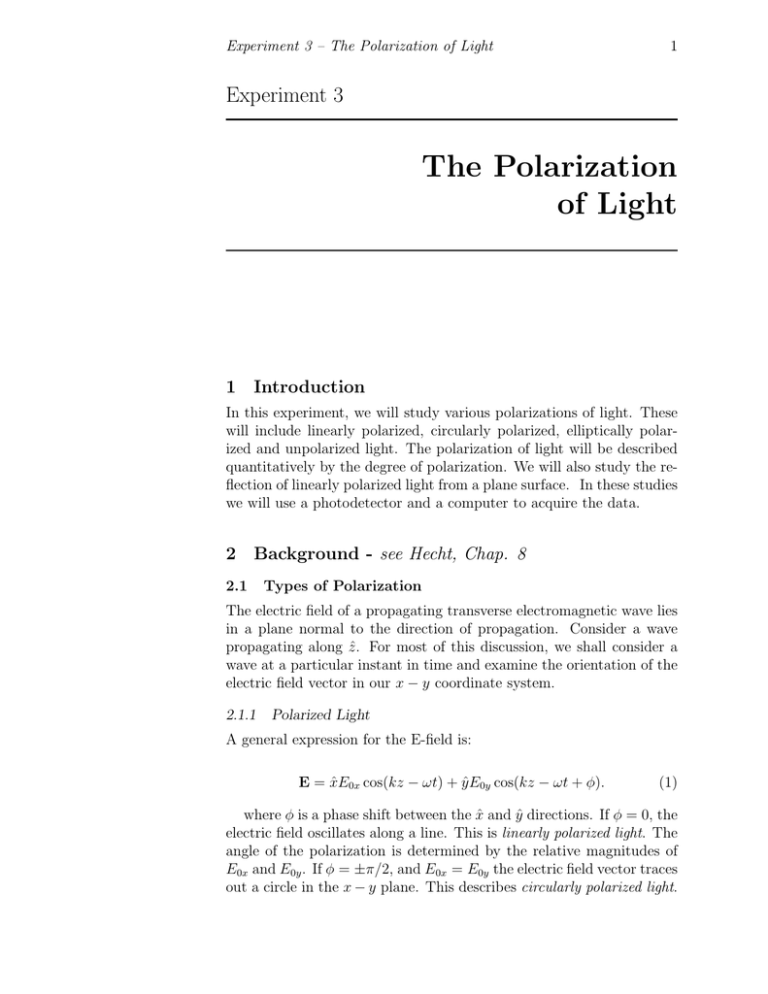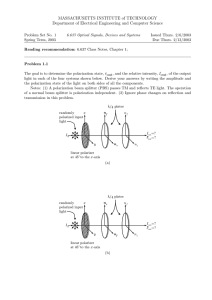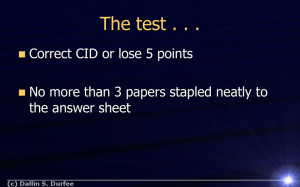The Polarization of Light
advertisement

Experiment 3 – The Polarization of Light 1 Experiment 3 The Polarization of Light 1 Introduction In this experiment, we will study various polarizations of light. These will include linearly polarized, circularly polarized, elliptically polarized and unpolarized light. The polarization of light will be described quantitatively by the degree of polarization. We will also study the reflection of linearly polarized light from a plane surface. In these studies we will use a photodetector and a computer to acquire the data. 2 Background - see Hecht, Chap. 8 2.1 Types of Polarization The electric field of a propagating transverse electromagnetic wave lies in a plane normal to the direction of propagation. Consider a wave propagating along ẑ. For most of this discussion, we shall consider a wave at a particular instant in time and examine the orientation of the electric field vector in our x − y coordinate system. 2.1.1 Polarized Light A general expression for the E-field is: E = x̂E0x cos(kz − ωt) + ŷE0y cos(kz − ωt + φ). (1) where φ is a phase shift between the x̂ and ŷ directions. If φ = 0, the electric field oscillates along a line. This is linearly polarized light. The angle of the polarization is determined by the relative magnitudes of E0x and E0y . If φ = ±π/2, and E0x = E0y the electric field vector traces out a circle in the x − y plane. This describes circularly polarized light. Experiment 3 – The Polarization of Light 2 If φ 6= 0, ±π/2 and/or E0x 6= E0y , the light is elliptically polarized. The electric field traces out an ellipse, that in general can have any major to minor axis ratio and an arbitrary angle. 2.1.2 ”Unpolarized” Light If light is monochromatic, it is polarized. It must be some form of elliptically polarized light (where we consider linear and circular to be limiting cases.) For light to be ”unpolarized” requires a random phase variation between the x and y components of the field, and some time averaging. All light is always fully polarized at any instant in time. Unpolarized light is only possible if there are multiple frequencies present. Our HeNe lasers may or may not be fully polarized. They tend to lase in a few ”modes” with orthogonal polarizations, producing light separated in frequency by ∼ 1 GHz (note this is only a part in 105 of the optical frequency, so it still looks monochromatic). We will learn more about lasers later in the course, but at the moment, what you need to know is that over time (minutes to hours) the amount of light in the two modes can drift. If it is all in one mode, the laser will be linearly polarized. If it lases in both modes with equal intensity, it will appear unpolarized (because any measurement we make will average over many cycles of the difference frequency). This drift will be an impediment to your measurements, and some of you will be lucky and will have much more stable lasers than others. To do experiments we will put one polarizer in front of the laser to make it linearly polarized, but how much light is transmitted through this polarizer will depend on the state of the laser (and may change in time!). 2.2 Malus’s Law Consider polarized light of intensity I(0) incident on an ideal linear polarizer. Let the transmission axis of this polarizer be at an angle of θ with respect to the initial polarization. Only light with it’s electric field vector parallel to the axis of the polarizer will be transmitted through the polarizer. The intensity of the light emerging from the second polarizer is given by Malus’ Law: I(θ) = I(0) cos2 (θ). (2) To go one step further, consider the situation where light from the first polarizer is incident on a second polarizer whose transmission axis is at an angle of ψ with respect to the initial polarization. The intensity of light emerging from the second polarizer is given by I(ψ) = I(0) cos2 (θ) cos2 (θ − ψ). (3) Experiment 3 – The Polarization of Light 2.3 3 Degree of Polarization The degree of polarization is basically a measure of the extent to which the light we are studying is polarized and is given by: V = Imax − Imin , Imax + Imin (4) where Imin and Imax are the minimum and maximum intensities of the light, respectively. For partially polarized light, this can also be written as: Ip V = , (5) Ip + Iup where Ip is the intensity of the polarized portion and Iup is the intensity of the unpolarized portion. Sometimes V is called the fringe visibility. 2.4 Reflection of Linearly Polarized Light When linearly polarized light is incident on a plane surface, the amount of light reflected, the reflectance (R), depends on the angle of incidence and the orientation of the polarization vector relative to the scattering plane. This is described by the Fresnel equations: tan (θi − θt ) 2 (6) Rk = tan (θi + θt ) sin (θi − θt ) 2 . R⊥ = sin (θi + θt ) (7) One consequence of Eq. 6 is that when θi + θt = π/2, tan (θi + θt ) → ∞ and Rk → 0. This occurs when θi = θB where θB is called Brewster’s angle and θt = β. Substituting θB and β into Eq. 6, subject to θB +β = π leads to 2 nt tan θB = . (8) n0 At θB only light with its E-field perpendicular to the scattering plane will be reflected. Consequently, it is possible to produce polarized light from unpolarized light by allowing it strike an interface at Brewster’s angle. 3 Experiment You are supplied with 3 polarizers, one on a motorized rotation stage. You will have to deal with the laser drifts, so you will need to make stability measurements to disentangle effects due to the laser from your Experiment 3 – The Polarization of Light 4 measurements. Using the data acquisition system, measure the intensity stability of your laser, and then the time-dependent polarization state of your laser. Measure Brewster’s angle for the block of glass supplied. The polarizers’ axes are not marked, so you will need to figure out how to assure that the polarization of the beam striking the block is parallel to the plane of incidence. Verify Malus’ Law for one and two polarizers. A demonstration that mystifies many observers is that placing a polarizer in between two crossed polarizers allows light to be transmitted that was previously blocked. Set up this system and figure out why this is so. Go in the hallway and look at the light reflected off the floor. Is it polarized, and if so, along what direction? If you have or can borrow polarizing sunglasses, measure their polarization properties. Multiple scattering of light can affect the polarization state. Waxed paper makes a good multiple scatterer. Measure the polarization of the light after passing through a piece of waxed paper. An optically active medium has a different index of refraction for right- and left-circularly polarized light, which has the effect of rotating linearly polarized light. Sugar molecules are chiral - they have a lefthanded twist, so a sugar solution is optically active. Measure the effect of transmitting polarized light through a cell containing corn syrup. We only have two cells, so they need to be shared.




